


|
Issues 2, 5 & 10 feature Howard Pyle artwork |
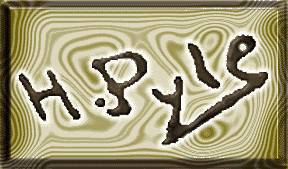 |
Howard Pyle is in #s 1-3 & 5 |
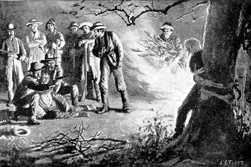 Second and foremost,
Howard Pyle was a teacher. That said, firstly he was an artist,
an artist who changed the way the world looked at illustration
and the way illustration looked to the world. Before Pyle, and
indeed for many years after his career started, illustrations
for adventure stories looked like the image at right. Their most
noticeable trait was their "staginess" - the flat "stage"
of the ground, the posed "actors" and the scenery "props"
to support them. It could easily have been photographed from front
row center. The stage manger might call "break" and
the actors would walk off and prepare for the next scene. And
this is the good stuff - A.B. Frost from 1890.
Second and foremost,
Howard Pyle was a teacher. That said, firstly he was an artist,
an artist who changed the way the world looked at illustration
and the way illustration looked to the world. Before Pyle, and
indeed for many years after his career started, illustrations
for adventure stories looked like the image at right. Their most
noticeable trait was their "staginess" - the flat "stage"
of the ground, the posed "actors" and the scenery "props"
to support them. It could easily have been photographed from front
row center. The stage manger might call "break" and
the actors would walk off and prepare for the next scene. And
this is the good stuff - A.B. Frost from 1890.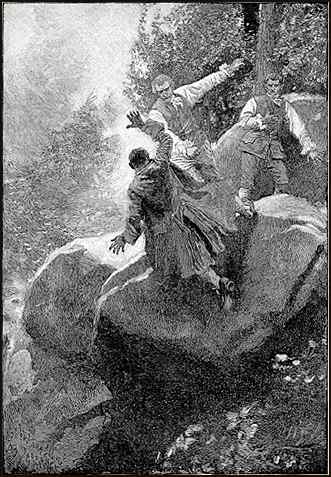 Then Pyle
showed up. Born in 1853, he seemed determined from a precociously
early age to become an author and more importantly an artist.
By 1876, he moved to New York at the encouragement of Scribner's
Magazine, for whom the drawing at left was made, also in 1890.
Compare it with the Frost. First off, we know this isn't a stage
- we can't even see the ground. The scenery seems very un-prop-like,
and it's quite obvious that the only "break" that's
going to occur at the end of this scene is someone's leg or head.
The tension in the Frost scene is in our minds, that of Pyle's
is before our eyes. His every drawing wasn't this dynamic, nor
was every assignment rife with such potential scenes, but Pyle
saw the action in art, and put it on the page for all to share.
He also shared his views and skills with an amazing student body
at his 1896 classes at the Drexel Institute of Arts and Sciences
in Philadelphia, his summer classes at Chadds Ford, Pennsylvania,
and at his own school in Wilmington, Delaware - started in 1903.
In the first Drexel class were Violet Oakley, Maxfield Parrish,
and Jessie Willcox
Smith. The first Wilmington class included: Stanley
Arthurs, W.J. Aylward, Ida Daugherty, Harvey Dunn,
George Harding, Percy Ivory, Thornton Oakley, Frank Schoonover and N.C. Wyeth. (Dunn was to pass the Pyle
legacy on to another generation with his own teaching.) Pyle's
students were to revolutionize the illustration world. Today they
are collectively known as The Brandywine School. By 1910,
with the obvious exceptions of drawing room dramas, few artists
capable of it thought twice of portraying an action scene from
an unusual perspective or placing the action in the setting of
their choosing.
Then Pyle
showed up. Born in 1853, he seemed determined from a precociously
early age to become an author and more importantly an artist.
By 1876, he moved to New York at the encouragement of Scribner's
Magazine, for whom the drawing at left was made, also in 1890.
Compare it with the Frost. First off, we know this isn't a stage
- we can't even see the ground. The scenery seems very un-prop-like,
and it's quite obvious that the only "break" that's
going to occur at the end of this scene is someone's leg or head.
The tension in the Frost scene is in our minds, that of Pyle's
is before our eyes. His every drawing wasn't this dynamic, nor
was every assignment rife with such potential scenes, but Pyle
saw the action in art, and put it on the page for all to share.
He also shared his views and skills with an amazing student body
at his 1896 classes at the Drexel Institute of Arts and Sciences
in Philadelphia, his summer classes at Chadds Ford, Pennsylvania,
and at his own school in Wilmington, Delaware - started in 1903.
In the first Drexel class were Violet Oakley, Maxfield Parrish,
and Jessie Willcox
Smith. The first Wilmington class included: Stanley
Arthurs, W.J. Aylward, Ida Daugherty, Harvey Dunn,
George Harding, Percy Ivory, Thornton Oakley, Frank Schoonover and N.C. Wyeth. (Dunn was to pass the Pyle
legacy on to another generation with his own teaching.) Pyle's
students were to revolutionize the illustration world. Today they
are collectively known as The Brandywine School. By 1910,
with the obvious exceptions of drawing room dramas, few artists
capable of it thought twice of portraying an action scene from
an unusual perspective or placing the action in the setting of
their choosing.

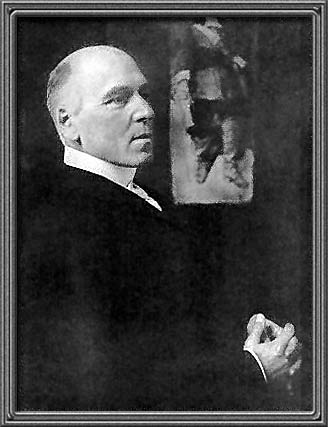 Pyle
wrote many of the books and stories he illustrated, and though
he will always be remembered first for his art, many of his books
are considered classics and still in print or available in recent
reprints. These include: The Merry Adventures of Robin Hood,
Pepper & Salt, The Wonder Clock,
Otto of the Silver Hand, Men of Iron,
The Garden Behind the Moon, and the four volume Arthurian
legends comprised of The Story of King Arthur and His Knights,
The Story of the Champions of the Round Table, The
Story of Lancelot and His Companions, and The Story
of the Grail and the Passing of Arthur. Most of these were
illustrated with his distinctive pen & ink style that hearkened
back to the wood-engraved images that were common during his childhood
and early years of his career. He wasn't restricted to this more-formal
style, but seemed to gravitate towards it in pen illustrations
for his own work.
Pyle
wrote many of the books and stories he illustrated, and though
he will always be remembered first for his art, many of his books
are considered classics and still in print or available in recent
reprints. These include: The Merry Adventures of Robin Hood,
Pepper & Salt, The Wonder Clock,
Otto of the Silver Hand, Men of Iron,
The Garden Behind the Moon, and the four volume Arthurian
legends comprised of The Story of King Arthur and His Knights,
The Story of the Champions of the Round Table, The
Story of Lancelot and His Companions, and The Story
of the Grail and the Passing of Arthur. Most of these were
illustrated with his distinctive pen & ink style that hearkened
back to the wood-engraved images that were common during his childhood
and early years of his career. He wasn't restricted to this more-formal
style, but seemed to gravitate towards it in pen illustrations
for his own work.
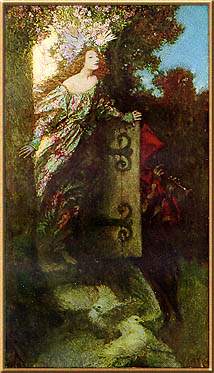

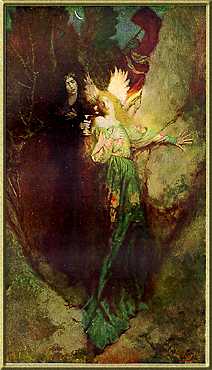

Travels of the Soul
And then there was color. Rich earth tones played against bright
primaries in strong and complex compositions, often framed in
deep, impenetrable shadow. Most of these were prized additions
to issues of Century, Everybody's and Harpers
monthly magazines from 1900 to 1911 when the color printing processes
were advanced enough to do justice to his palette. The four panels
above are from the 1902 Christmas issue of Century, "The
Travels of the Soul" (and reproduced in ImageS #2). "Told in four paintings and a decorated
text by Howard Pyle." Pyle's work was highly prized by the
publishers of the day and Pyle was instrumental in exposing the
work of his students to those same publishers, helping most of
them begin long and productive careers.
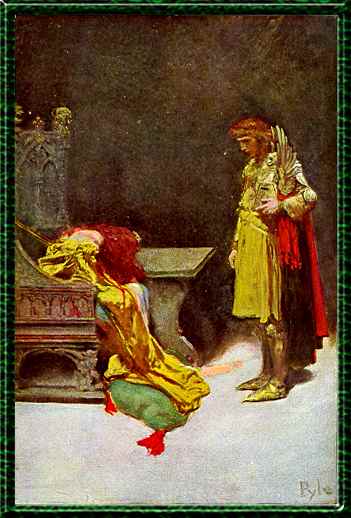
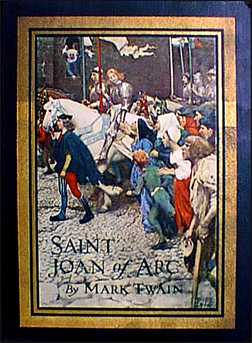 The image
at left is from the 1905 edition of The Island of Enchantment,
one of dozens of books he illustrated during his heyday. At the
right is the cover of one of the final books to appear featuring
his work, Saint Joan of Arc, by Mark Twain. Published in
1919, eight years after his death, the images were done in 1904
for Harpers.
The image
at left is from the 1905 edition of The Island of Enchantment,
one of dozens of books he illustrated during his heyday. At the
right is the cover of one of the final books to appear featuring
his work, Saint Joan of Arc, by Mark Twain. Published in
1919, eight years after his death, the images were done in 1904
for Harpers.
Pyle died from a kidney infection while he was in Italy in 1911. His legacy is ongoing. The Henry Pitz biography has a list of 110 students that attended his various classes. An important fact is that fully 40 of these were women, including Eleanor Plaisted Abbott, Alice Barber Stevens, Anna Whelan Betts, Elizabeth Shippen Green, Charlotte Harding (Brown), Gertrude A. Kay, Katherine Pyle, Sarah Stilwell Weber, and more. The influence of these women, the impact of Wyeth and Dunn, and the attitudes towards illustration that they all developed from Pyle's teachings keep his works and memory alive today in every art class that teaches illustration. And every bookstore that sells illustrated books from the Golden Age.
The Brandywine
River Museum and the Delaware Art Museum are two excellent repositories
of this legacy. Visit them if you can.
 Learn more about Pyle and his students.
Learn more about Pyle and his students.
| Howard Pyle - A Chronicle | Charles D. Abbott, 1925 Harper & Bros. |
| Howard Pyle - Writer, Illustrator, Founder of the Brandywine School | Henry C. Pitz, 1975 Clarkson N. Potter |
| The Brandywine Tradition | Henry C. Pitz, 1968 Houghton Mifflin |
| The Brandywine Heritage | 1971 The Brandywine River Museum |
| American Illustration 1890-1925 | Judy L. Larson, 1986 Glenbow Museum |
| American Illustration | Rowland Elzea, 1991 The Delaware Art Museum |
| The Illustrator in America 1900-1960's | Walt Reed, 1966 Reinhold |
| The Illustrator in America 1880-1980 | Walt and Roger Reed, 1984 Madison Square Press |
| Howard Pyle | Rowland Elzea, 1975 Peacock Press/Bantam Books |
| The Wyeths by N.C. Wyeth | Betsy Wyeth, 1971 Gambit |
| The Vadeboncoeur Collection of Knowledge | Jim Vadeboncoeur, Jr., 1997 |
| The Vadeboncoeur collection of ImagesS #2,5,10, B&W 1-3,5 | Jim Vadeboncoeur, Jr. 2001-2004, 2006, 2008, 2010 JVJ Publishing |
|
Illustrations copyright by their respective
owners. This page written, designed & © 1997 by Jim Vadeboncoeur, Jr. Updated 2011. |
Learn about other ILLUSTRATORS
